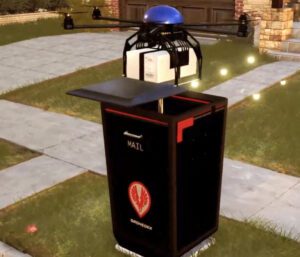 How Looser Federal Drone Regulations Could Help The Supply Chain Backlog
How Looser Federal Drone Regulations Could Help The Supply Chain Backlog
The following is a guest post by Dan O’Toole, founder and CEO, DRONEDEK: creators of a drone delivery mailbox. DRONELIFE neither accepts nor makes payment for guest posts.
The global supply chain backlog is at best an inconvenience for holiday shoppers and at worst has led to layoffs and/or manufacturing mayhem as microchips or other items critical to factory production are held hostage to delivery congestion.
Package delivery by drone isn’t going to get the factory floors back to top efficiency, but it does promise long-term and lasting improvements to the environment and consumer convenience. Currently, the last-mile of the delivery chain – that distance between distribution hubs and consumers’ homes – is woefully inefficient and environmentally harmful.
Anyone living in even a small city or town has seen this with their own eyes: Amazon, FedEx, USPS, DHL and UPS trucks circle city blocks repeatedly as human beings drive from point A to B to D and back to A again delivering packages to porches where they may or may not remain until the homeowners retrieve them. Delivery companies work hard to maximize trips and minimize fuel and other costs, but the miles still add up.
In the U.S., 100 million packages are delivered daily to 160 million addresses. Four thousand addresses are added daily. Ninety-one percent of those packages weigh five pounds or less. The Christmas season and pandemic-inspired Work From Home lifestyles have increased consumers’ embrace of package delivery.
With drone delivery – ideally to a secure, smart mailbox – those cargo vans can park in a central location and send out drones to take care of those last inches and feet of the supply chain, reducing drive time. They can then re-supply and move on to serve another neighborhood from the air.
 DRONE DELIERY IS ECO- AND HUMAN-FRIENDLY
DRONE DELIERY IS ECO- AND HUMAN-FRIENDLY
An Australian study showed increased drone delivery could reduce carbon dioxide emissions by 8,000 tons. and 35 million vehicle kilometers could be saved each year. Drone delivery to a DRONEDEK smart mailbox saves time, money, and physical exertion by:
- Reducing expense – the average cost of last-mile drone delivery is $1 compared to $2 by truck.
- Increasing efficiency – drone delivery eliminates the need for trucks to drive repeatedly through neighborhoods.
- Saving physical exertion on the part of the part of the delivery person.
- Providing package security – packages are locked in the mailbox and opened only via app.
- Providing a charging station to keep the drones flying; and
- Boosting the Long Range (LoRa) network with hotspots for Helium’s People’s Network and using lower bandwidth sensors instead of relying on cellular networks where possible.
DRONE DELIVERY INCREASES SAFETY
The Christmas shopping season increases pressure on delivery companies and personnel as drivers are in a constant state of alert to deliver on time to keep their jobs and customers happy. Statistics show that nearly 20% of workplace fatalities occur in delivery-related driving incidents and there are more worrying statistics related to food distribution.
Widespread adoption of last-mile delivery drones secured by individual smart mailboxes will significantly reduce accident occurrence rates. The 2018 Alpha Beta study cited above showed increased drone delivery could prevent 70 road accidents a year in Australia.
DRONE REGULATORS NEED TO RELAX
Many other countries are ahead of the U.S. in rolling out drone delivery. Policy makers here talk about relaxing regulations for truck drivers, but they need to be looking at drone regulation as well. Industry experts project double digit growth for the drone delivery sector in the next few years if regulations are eased. We support relaxation of “line of sight” regulations as well as those that currently prevent night-time drone flying and the ability to fly drones over crowds are also areas where real-life experience should drive regulations rather than have regulations keep those activities from happening.
We believe if pilots can just be free to hone their skills, real-time use will show regulators what’s needed. Drone delivery technology is moving too fast for the regulatory process to keep up. Just as with telecommunications, regulators should get out of the way and let the market drive this sector.
FREE THE SKIES AND WATCH DRONE INNOVATION SOAR
Drone delivery is a nascent industry. For it to flourish, we need to free the skies and let the drones fly. Policy makers simply can’t keep up with the technology that will only increase as this sector takes off.
Right now, drone delivery is accomplished in the U.S. in fields and yards, sometimes with a parachute to protect landings. We need widespread pilot projects to get drones flying everywhere to see what kinds of limitations are truly needed and which are just impeding progress.
The DRONEDEK smart mailbox is one example of innovation that is ahead of the industry, and we are designing it knowing its features will be in constant iteration as we learn more about what the drones will require and what consumers want.
Right now, we know consumers want a smart mailbox that can keep food hot or cold; they want a safe and secure receptacle that porch pirates can’t breach; they want reliable, efficient delivery that doesn’t do further harm to the environment.
The best way for drone delivery to expand and deliver for consumers is encourage – not impede – those who are pioneering the necessary technology.
https://www.jdsupra.com/legalnews/dangers-delivery-drivers-face-2697544/
Read more about residential drone delivery with Walmart and Zipline, Walmart and DroneUp , Google Wing, BVLOS regulations, and last mile delivery logistics.
 Dan O’Toole, DRONEDEK CEO/FOUNDER BIO is a serial entrepreneur and business leader who is among the first in the United States to secure patents for a smart mailbox designed to securely accept packages delivered by drone. DRONEDEK holds a First-Position Patent Portfolio for the next-generation mailbox of autonomous and drone delivery. Two issued US Utility Patents, two additional utility patents are under examination now and two PCT’s. In all 111 patent claims already awarded or filed for.
Dan O’Toole, DRONEDEK CEO/FOUNDER BIO is a serial entrepreneur and business leader who is among the first in the United States to secure patents for a smart mailbox designed to securely accept packages delivered by drone. DRONEDEK holds a First-Position Patent Portfolio for the next-generation mailbox of autonomous and drone delivery. Two issued US Utility Patents, two additional utility patents are under examination now and two PCT’s. In all 111 patent claims already awarded or filed for.
Dan is a Ball State University graduate and lives in Carmel, Ind. with his family. He is also CEO/Managing Broker at Striker Realty Group.

Miriam McNabb is the Editor-in-Chief of DRONELIFE and CEO of JobForDrones, a professional drone services marketplace, and a fascinated observer of the emerging drone industry and the regulatory environment for drones. Miriam has penned over 3,000 articles focused on the commercial drone space and is an international speaker and recognized figure in the industry. Miriam has a degree from the University of Chicago and over 20 years of experience in high tech sales and marketing for new technologies.
For drone industry consulting or writing, Email Miriam.
TWITTER:@spaldingbarker
Subscribe to DroneLife here.







[…] मिरियम मैकनाब DRONELIFE के प्रधान संपादक और JobForDrones के सीईओ हैं, जो एक पेशेवर ड्रोन सेवा बाज़ार है, और उभरते ड्रोन उद्योग और ड्रोन के लिए नियामक वातावरण का एक आकर्षक पर्यवेक्षक है। मिरियम ने वाणिज्यिक ड्रोन स्पेस पर केंद्रित 3,000 से अधिक लेख लिखे हैं और उद्योग में एक अंतरराष्ट्रीय वक्ता और मान्यता प्राप्त व्यक्ति हैं। मिरियम के पास शिकागो विश्वविद्यालय से डिग्री है और नई तकनीकों के लिए उच्च तकनीक बिक्री और विपणन में 20 से अधिक वर्षों का अनुभव है। ड्रोन उद्योग परामर्श या लेखन के लिए, ईमेल मरियम. […]